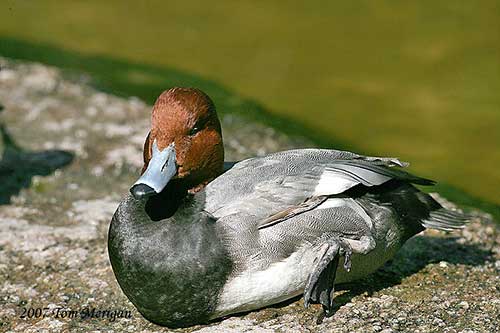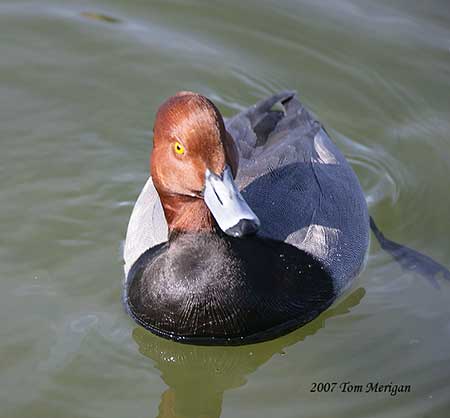
Fr: Fuligule à tête rouge
Ang: Redhead
All: Rotkopfente
Esp: Porrón Americano
Ita: Moriglione americano
Nd: Amerikaanse Tafeleend
Sd: amerikansk brunand
Photographers:
Jean Michel Fenerole
Photos d’Oiseaux du monde
Tom Grey
Tom Grey's Bird Pictures & Tom Grey's Bird Pictures 2
Tom Merigan
Tom Merigan’s Photo Galleries
Text by Nicole Bouglouan
Sources:
HANDBOOK OF THE BIRDS OF THE WORLD vol 1 by Josep del Hoyo-Andrew Elliot-Jordi Sargatal - Lynx Edicions - ISBN: 8487334105
GUIDE DES CANARDS, DES OIES ET DES CYGNES – de Steve Madge - Delachaux et Niestlé - ISBN: 2603013769
FIELD GUIDE TO THE BIRDS OF NORTH AMERICA - National Geographic Society - ISBN: 0792274512
BIRDS OF THE GREAT BASIN – by Fred A. Ryser, Jr - University of Nevada Press -ISBN: 0874170796
Animal Diversity Web (University of Michigan Museum of Zoology)
SORA - COURTSHIP OF THE REDHEAD (AYTHYA AMERICANA)
SORA - GROWTH, WEIGHTS, AND PLUMAGES OF THE REDHEAD, AYTHYA AMERICANA
Conserving Canada Wetlands
Tennessee Wildlife Resources Agency
South Dakota Birds and Birding – (Terry L. Sohl)
What Bird-The ultimate Bird Guide (Mitchell Waite)
Wikipedia, the free encyclopaedia
Redhead
Aythya americana
Anseriformes Order – Anatidae Family
INTRODUCTION:
The Redhead is a diving duck adapted to foraging underwater. It is found in North America, from N Canada to the Caribbean. It frequents freshwater swamps, lakes and marshes when breeding. During winter it can be seen in brackish coastal lagoons and even at sea, several kilometres from the shore. It typically feeds on plant material and aquatic invertebrates.
The Redhead is solitary nester or nests in loose groups. The female builds the nest in dense reedbeds or other vegetation, near open, shallow water. The female alone rears the chicks.
This species is affected by drainage of wetlands in the breeding range, and by recreational activities in Canada. Hunting pressure has also a negative impact on populations.
However, the Redhead is not considered globally threatened.

DESCRIPTION OF THE BIRD:
Biometrics:
Length: 42-54 cm
Wingspan: 75-79 cm
Weight: M: 910-1220 g – F: 910-1110 g
The Redhead adult male has white with blackish vermiculations back and body sides, giving it dark appearance. On the wings, the primaries are brownish-grey, paler near the tips. The secondaries are paler, mostly pearl grey with darker rear fringes. The tertials are grey. Tail and coverts are blackish, paler towards the tip.
On the underparts, lower neck and breast are black. The belly is white, like the underwing.
Head and upperneck are chestnut-red.
The bill is mostly pale blue with faint, white subterminal band and black tip. The eyes are yellowish-orange. Legs and webbed feet are grey.
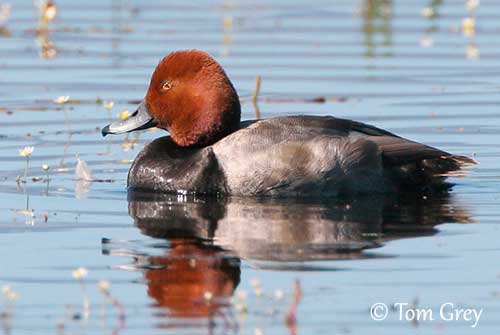
The male in eclipse plumage resembles female, but head and neck are browner. The breast is mottled, back and rump are brown-blotched. The bill is darker. The eyes are dull yellow-orange.
The adult female has greyish-brown back and body sides, sometimes flecked white. The wings are brownish-grey with darker tips to primaries. Other flight-feathers are like on male.
On the underparts, the breast is brown, the belly is white, tail and coverts are greyish-brown, paler towards the tip.
Head and neck are yellowish-brown with darker crown. The face shows paler bill base and rear of the eye, pale eyering and scattered white feathers on the nape.
Bill, legs and feet are like on male. The eyes are brown to yellowish-brown.
The juvenile resembles female with heavier mottling. The first winter male is similar to female but duller overall. Some individuals may be pale rufous to blackish-brown.
Male and female Redhead differ from very similar Common Pochard and Canvasback by bill colour and head shape, and some differences in plumage pattern.
Hybrids between Aythya species often involve complex identification problems.
RANGE:
The Redhead breeds from S Canada to N USA (Washington to Maine). Most of them breed in the Prairie Pothole Region (N Great Plains of North America). This area includes thousands of shallow pools. Some populations also breed in Central Alaska.
It migrates in September to winter in N and C Mexico, and from California to the Gulf and Atlantic Coast. Numerous birds winter in Florida and Mexico.
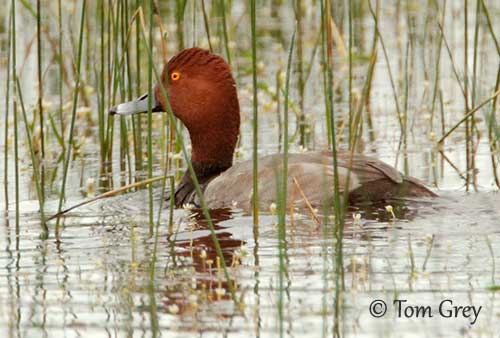
HABITAT:
The Redhead frequents shallow, freshwater lakes, ponds and marshes during the breeding season in the Prairie Pothole Region where dense reedbeds and emergent vegetation provide them food and cover.
But it may also nest in other type of habitat such as reservoirs, sewage ponds, streams and also large marshes of the Great Basin and Canada.
On migration, they form large flocks on lakes, reservoirs, rivers, pools and bays. During winter, they can be seen on brackish and coastal bays and lakes.
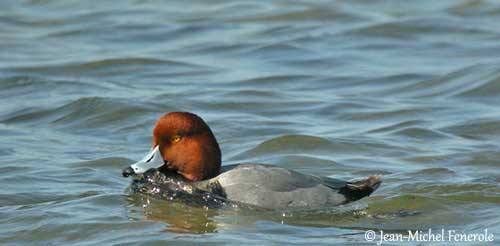
CALLS AND SONGS: SOUNDS BY XENO-CANTO
The Redhead is usually silent outside of breeding season. During the courtship displays in spring, the male produces a wheezy “whee-ough” and a cat-like “meow” also heard when greeting a partner of after copulation.
During the courtship, the female utters some “quek, que-e-ek” and a soft, low “err”. A loud, clear “squak” can be heard while the bird takes flight from the water.
During winter, we can only hear a faint “zoom-zoom” given by the male but mainly at night.
BEHAVIOUR IN THE WILD:
The Redhead feeds primarily on plant matter, usually submerged aquatic plants of several species. Some invertebrates such as molluscs, fish-eggs and insects are also part of the diet.
The Redhead is known as a diving duck, but it frequents mainly shallow waters, and even diving to the bottom to reach aquatic plants, if feeds more by dabbling than diving, that allows it to catch some insects. It can be seen upending like the dabbling duck species, or by submerging both head and neck.
The Redhead is gregarious and often feeds with other duck species.
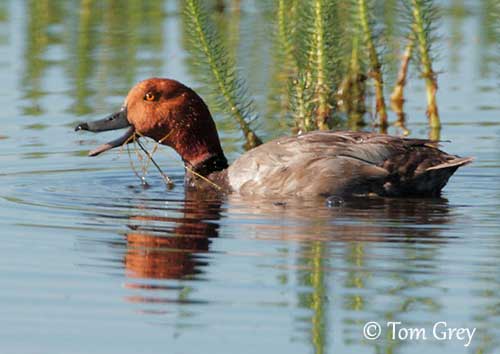
The Redhead is seasonally monogamous. The pair forms on the wintering grounds and the pair-bond strengthens while they return to the nesting areas. Courtship displays can be seen up to April.
The female leads the displays while she stands up tall. She jerks the head up and down before to hold it erect. The male also stands erect and twirls around to display its backside to her. The female may nip at him, or dash off and intersect him while swimming.
The male may drive rivals away if the female is interested by more than one male at a time.
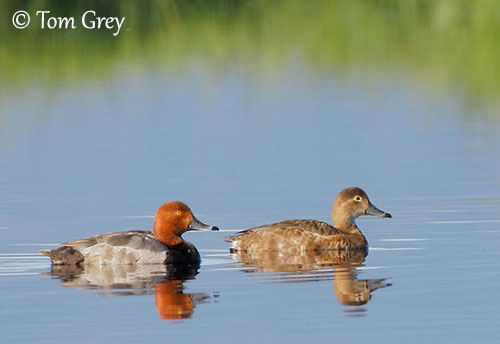
The Redhead female is also known for egg-laying strategies, and she can become parasitic.
In normal behaviour, a female lays and incubates her own eggs.
But she also may lay eggs in other nests, and even all her eggs in another duck’s nest, usually at the end of the incubation. In this case, the eggs of the parasitic female will probably not hatch and will be wasted.
Usually, 3-4 females will parasitize a single host nest. In the Great Basin, numerous Redhead nests were found with 19-39 eggs, and clutches with as many as 87 eggs have been found. This behaviour is named “dump nesting”. In average, 5,4 eggs per nest failed to hatch, probably not fully incubated.
The Canvasback is affected by this problem, where breeding range and habitat of both species overlap.
The Redhead is migratory and moves S after breeding to reach the lowlands of S Canada, USA, Mexico, Central America and West Indies.
The species is vagrant is Greenland, Bermuda, Iceland, Britain, Ireland, NE Siberia, E China, Japan, Guam and Hawaii.
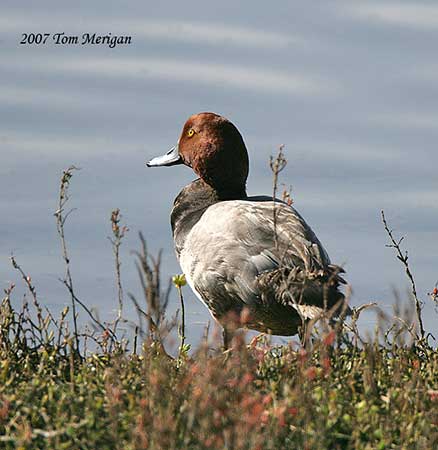
The Redhead has faster, direct flight than other duck species. It performs rapid, shallow wingbeats, but the flight pattern is more erratic than that of the Canvasback.
During the spring migration, they often move in small flocks of less than 25 individuals, sometimes associated with other Aythya species. They fly in V formation.
REPRODUCTION OF THIS SPECIES:
The breeding season takes place between April/May and late July. The pair flies low over marshes while searching for a suitable nesting site. The female also swims among the dense aquatic vegetation while the male waits in the close surrounding.
She builds the nest alone, often among cattails and bulrushes, but sometimes on uplands or islands on shallow water. In high water levels, she may nest atop of muskrat houses.
The nest is circular, built on submerged vegetation used as foundations. She forms a bowl with woven plant material taken near the nest. Then, she plucks feathers from her breast to make a soft lining inside the bowl.
The female may build a cover by bending vegetation over the nest, and sometimes, a ramp is added from the nest to the water.
She lays 7-14, usually 9 pale olive, buff or dull white eggs. She incubates alone during 23-29 days. The male abandons her at this period.
At hatching, the chicks have yellowish-brown down, darker brown above and yellowish below and on face. They usually leave the nest within 24/48 hours. They fledge between 56 and 73 days after hatching.
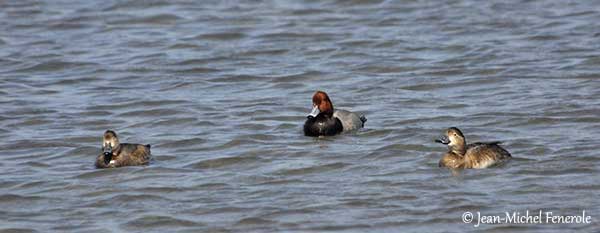
The female Redhead is not a very good mother. She tends to desert nest and eggs quickly when threatened by flooding, parasitic intrusions (see “behaviour”) and other disturbances. She deserts her brood quite early in life, usually before the young are able to fly. The young can be seen flapping across the water, and they learn to fly at about 70-84 days old.
This species produces a single brood per season.
PROTECTION/THREATS/STATUS:
The Redhead has lost its breeding habitat due to drainage of wetlands. Disturbances caused by recreational activities and hunting pressure have a negative impact on this species. Pollution from agriculture and severe drought conditions are important problems too.
However, the population is suspected to be stable and slightly increasing since 1950s.
The Redhead is not globally threatened and the species is currently evaluated as Least Concern.
